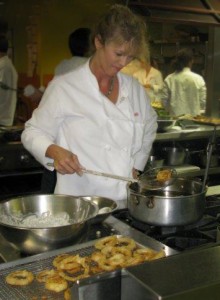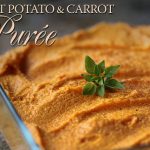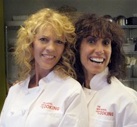
PHOTOGRAPHY BY: CATHY NELSON ARKLE
Recipes & Ramblings from Chef School
We all know we’re supposed to eat vegetables… because our mothers told us so. But there are other reasons to eat them as well. Today we will be learning about the virtues of vegetables.
The body uses almost as many calories to digest vegetables as there are in them. Over 95% of vegetables contain less than a gram of fat per serving and are full of fiber. This means you can fill up for less!
According to the American Cancer Society, phytochemicals found in vegetables are promoted for the prevention and treatment of many health conditions including cancer, heart disease, diabetes, and high blood pressure.

Vigorous Vegetables
In class we learned about summer and winter vegetables. The varieties are so immense, and their cooking methods so splendidly varied, that there’s something for everyone. Rona talks about the winter vegetables and how to prepare them in her blog. Click here to read.
Jack Bishop, author of “Vegetables Every Day” divides cooking techniques for vegetables into dry and moist-heat methods. He says it much better than I would.
MOIST-HEAT METHODS
Moist heat cooking refers to various methods for cooking food with, or in, any type of liquid — whether it’s steam, water, stock, wine or something else.
Blanch & Shock: Vegetables are briefly put into a saucepan of boiling water and the timing begins immediately. This method doesn’t fully cook the food but softens the texture.
To stop the cooking and set the color, “refresh” vegetables by immediately draining and plunging them into ice water.
Vegetables can be blanched a day in advance of serving. Once they’re refreshed, pat with paper towels, then wrap in dry towels, place in a plastic bag and refrigerate. Finish cooking by sauteing or stir-frying the vegetables.
Blanching and refreshing also are necessary before freezing vegetables to keep the enzymes from breaking down both color and texture.
Boil: You have up to seven minutes before there is a major color change, so timing is everything.
Vegetables should be added to rapidly boiling water, and the timing should begin only when the water returns to the boil. Always leave the pan uncovered.

SWISS CHARD WITH ONIONS
Braise: Vegetables contain lots of natural moisture, which releases in cooking. Lightly brown the vegetable in a little fat, then add a tablespoon or two of liquid to start the cooking process. Cover the pan and cook slowly over medium-low heat. Once the vegetable has released its moisture, add only enough additional liquid to keep it moist.
Poach: This technique is similar to boiling but uses less liquid and a lower heat to gently cook more fragile vegetables.
Steam: A large pot and a simple steamer basket are the tools needed to cook vegetables with this method. Don’t pack the basket too tightly and with food or the cooking will be uneven. Bring the water to a boil before placing the covered basket above the pot.
DRY-HEAT METHODS
These evaporate moisture in the vegetables quickly, which causes juices to brown and natural sugars to concentrate and become very flavorful.
Broil: The heat source is above the food, making this a great technique for blistering the skins of sweet peppers or chilies for easy peeling and a smoky flavor. Sliced vegetables should be brushed lightly with oil to keep them from drying out under the high heat.
Grill: This technique is similar to broiling, but the heat source comes from below, and a basting liquid is needed to keep food moist.
Roast: Toss with a light coating of olive oil, sprinkle lightly with salt, then roast in a single layer, shallow, rimmed baking sheet. The high temperature of 400 degrees or above causes the vegetables to shrink and lose their natural moisture, which concentrates the sugars and deepens the flavor. Yum!

ROASTED CAULIFLOWER WITH SALSA VERDE
Sauté: The pan size should be large enough to cook the vegetables in a single layer without crowding. The bottom of the pan should have a light coating of oil, or butter.
Stir-fry: Basically, this technique is similar to a sauté, but vegetables are cut into smaller pieces. Use medium-high to high heat for quick cooking and toss often.
Deep-frying: Since deep-frying involves submerging the food in hot, liquid fat, it is hard to believe it is actually a form of dry-heat cooking. If this seems confusing, remember that oil and water don’t mix, so while fat can take a liquid form, in many ways it’s the opposite of water — hence “dry” heat. Deep-frying requires keeping the oil at temperatures between 325°F and 400°F.
Class Assignments
After learning the above techniques for cooking vegetables, we were put to test. Rona made Grilled Vegetables with a refreshing yogurt-based Mint Raita.

Click here for the recipe on her blog.
I was highly challenged with the task of making beer-battered onion rings. I don’t like beer, onion rings, or anything else deep-fried… oh yes, and did I mention my fear of boiling oil?
I started with the batter, which seemed simple enough using 1 cup of beer and ¾ cup flour. It must be made at the last minute because the carbon dioxide dissipates quickly.
 Batter Up
Batter Up
To make the batter, whisk just enough beer (about ½ cup) into ¾ cup flour to make a smooth paste. Work the mixture as little as possible. Gently stir in another ½ cup beer. I must have worked too fast because my batter was lumpy. Graciously, my instructor made it again, flawlessly, sans lumps.
Onions were cut into ½” slices by a classmate as I was now behind schedule, having just finished making roasted cauliflower with salsa verde. She popped out and discarded the center of the onions, then separated the rings.
 Boiling oil was awaiting me. It was heated to 350 degrees, which I needed to maintain while I was cooking the onion rings. If the temperature gets too low, the oil penetrates the food and makes it taste greasy. And if it gets too hot, you better duck for cover as it can spit oil madly and start smoking, and Mom says smoking and spitting are nasty habits!
Boiling oil was awaiting me. It was heated to 350 degrees, which I needed to maintain while I was cooking the onion rings. If the temperature gets too low, the oil penetrates the food and makes it taste greasy. And if it gets too hot, you better duck for cover as it can spit oil madly and start smoking, and Mom says smoking and spitting are nasty habits!
 To keep from the oil from splattering, gently drop the onion close to the oil. No problem with tongs… but I was instructed to use my hands.
To keep from the oil from splattering, gently drop the onion close to the oil. No problem with tongs… but I was instructed to use my hands.
So I swirled my onions in the batter and nervously dropped each ring in the oil… jumping back each time as I anticipated the worst. Once a healthy respect for boiling oil was established, I was able to fry them until they were golden brown – two minutes per side. I put them on a rack and salted them immediately. They were actually quite light, non-greasy, and tasty. I was shocked.
 Homework Assignment
Homework Assignment
There were so many wonderful recipes to choose from this week. I decided to make several.
Click here to see the recipe for the Wild Mushrooms Crostini that Rona helped prepare in class. This is a fabulous hors d’oeuvre.
I also made the Sweet Potato & Carrot Puree because I couldn’t get enought of it in class.

Sweet Potato and Carrot Puree
Ingredients
- 4 large sweet potatoes
- 1 lb. carrots
- 2 ½ cup water
- 1 tablespoon granulated sugar
- 6 ounce unsalted butter softened
- salt the pepper to taste
- ½ cup crème fraiche or sour cream
- ½ teaspoon freshly ground nutmeg
- dash of cayenne optional
Instructions
-
Scrub potatoes and cut a small, deep slit in the top of each. Set on a sheet pan on the center rack of a preheated 375 degree oven and bake for about an hour, or until potatoes are tender when pierced with a fork.
-
Meanwhile, peel and trip the carrots and cut them into 1” lengths. Put them in a saucepan and add the water, sugar, 1 ounce of the butter, then salt and pepper to taste. Set over medium heat, bring to boil, and cook uncovered until the water has evaporated and carrots begin to sizzle in the butter, or about 30 minutes. The carrots should be tender. If not, add a little water and cook until the carrots are done and all the liquid has evaporated.
-
Scrape out the flesh of the sweet potatoes and combine with the carrots in the bowl of a food processor fitted with a steel blade. Add remaining butter and crème fraiche and process until very smooth.
-
Add nutmeg, and season to taste with salt and pepper. Add cayenne, if desired and process briefly to blend.
-
To reheat, transfer to an ovenproof serving dish and cover with foil. Heat in a preheated 350 degree oven for about 25 minutes or until steaming hot.
Recipe Notes
Serves 6
This recipe is down right sinful. If you have double helpings and your are Catholic, please leave extra time for confession. And unfortunately, the Vatican says Catholics can’t confess via iPhone’s new app; Confession: A Roman Catholic App.
“The greatest wealth is health.” – Virgil
If this is true… how can we not afford to eat vegetables?
…and then she paused for thought
Hope you have enjoyed our adventure in the culinary classroom. Join us each week as we continue learning new culinary skills.
You can also read about Rona’s experience on her blog or What’s Cookin online magazine.
Yum
This was a tough class for a favorite recipe-there were a lot of great tasting dishes that were pretty darn healthy, too! And I give props to my friend, Cathy for doing all that frying. I tasted one of the onion rings and they were surprisingly light and crunchy, without feeling oily. It seems that keeping the temperature high enough is an important factor-after all who DOESN’T have a 4 foot long thermometer to put into a huge pot of boiling oil?!
I may have had to do all the frying… but Rona, I don’t know how you did all that grillin’.
You are amazing! Keep on, keeping on. I look forward to every posting. Go Girl! Teach us how…
Thanks for the encouragement. It is always so appreciated.
I LOVE this post…especially the quote at the end that the greatest wealth is health, its so true. You made me really want to start filling my diet with more veggies, and try all of these different ways to make them! mmm 🙂